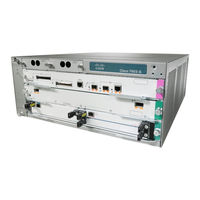Cisco 7609-S Manuals
Manuals and User Guides for Cisco 7609-S. We have 5 Cisco 7609-S manuals available for free PDF download: Configuration Manual, Installation Manual, User Manual
Cisco 7609-S Configuration Manual (1011 pages)
IOS Software Configuration Guide
Brand: Cisco
|
Category: Network Router
|
Size: 12.17 MB
Table of Contents
-
-
-
-
-
-
-
-
-
Configuring SSO106
-
-
-
-
-
Configuring VTP
177-
Configuring VTP182
-
-
-
-
-
-
Mst Overview248
-
Hop Count252
-
-
Configuring Mst261
-
-
Stp Overview276
-
Stp Port States280
-
Blocking State282
-
Listening State283
-
Learning State284
-
Forwarding State285
-
Disabled State286
-
Rstp Port Roles287
-
-
-
Configuring Stp296
-
Enabling Stp296
-
-
-
-
-
Configuring Ude
345-
Configuring Udlr348
-
-
Configuring Mpls358
-
-
-
Configuring Mvpn382
-
Advertisement
Cisco 7609-S Configuration Manual (742 pages)
Catalyst 6500 Series Switch and Cisco 7600 Series Router Firewall Services Module Configuration Guide Using the CLI
Brand: Cisco
|
Category: Network Router
|
Size: 7.89 MB
Table of Contents
-
-
New Features38
-
-
-
-
SVI Overview51
-
-
-
-
-
-
-
-
Bridge Groups113
-
-
-
-
Configuring OSPF151
-
OSPF Overview151
-
Enabling OSPF152
-
Monitoring OSPF162
-
-
Configuring RIP163
-
RIP Overview163
-
Enabling RIP163
-
-
-
Monitoring EIGRP171
-
Configuring DHCP177
-
-
-
-
AAA Overview205
-
-
-
Fallback Support210
-
User Profiles210
-
-
-
-
-
-
-
Failover Link256
-
State Link257
-
-
-
Regular Failover272
-
-
Cisco 7609-S Installation Manual (324 pages)
7600 Series
Brand: Cisco
|
Category: Network Router
|
Size: 11.91 MB
Table of Contents
-
-
Preface9
-
-
-
Conventions12
-
Cisco.com16
-
Cisco.com17
-
-
-
Redundancy37
-
Fan Assembly39
-
-
-
Load Sharing51
-
Pem52
-
-
Safety58
Advertisement
Cisco 7609-S Installation Manual (120 pages)
Installation Guide
Brand: Cisco
|
Category: Network Router
|
Size: 2.26 MB
Table of Contents
Cisco 7609-S User Manual (22 pages)
with Supervisor SUP720-3B
Brand: Cisco
|
Category: Network Router
|
Size: 0.45 MB
Table of Contents
-
-
Module6
-
Self -Tests20
-




